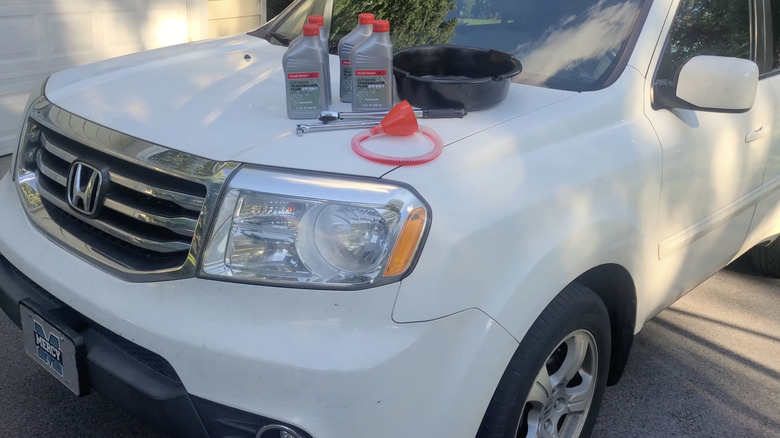Going To A Quick-Lube Shop Could Leave Your Honda's Transmission In Ruins - Here's Why
We may receive a commission on purchases made from links.
For simple maintenance jobs like topping up fluids or replacing wiper blades, it can make perfect sense to take your car to a quick lube shop. However, some components are more delicate than others — and in the case of Honda vehicles, that's the transmission. Here is why going to a quick lube shop might just destroy your Honda's gearbox.
A quick lube typically uses a high-pressure machine to force out the old transmission fluid and replace it with a new one. Still, some of Honda's CVT transmissions are particularly delicate since they don't rely on a planetary gear system like most transmissions, but rather clutch packs and hydraulic pressure controls, which are more akin to a manual transmission.
That said, high pressure can overload valve bodies, solenoids, internal seals, and dislodge components. Furthermore, any fluid other than the one recommended by Honda can also do more harm than good. To do this job properly and meet Honda's standards, you should only use Honda's transmission fluid — and stick to a basic drain-and-fill service.
Is a transmission flush machine bad for your Honda?
There has been much debate on whether a high-pressure transmission flush machine is bad for a car's transmission, but since Honda's CVT transmissions are different from most automatic transmissions, the risks are higher. Honda even issued the 2016 16-061 and the 2023 23-073 service bulletins in which the company strongly warns against using aftermarket flush systems.
As the later bulletin states: "The term flush refers to repeatedly draining and filling the transmission with Honda Genuine ATF-DW1. Other after market flush systems are available, but American Honda strongly recommends that you avoid using on any Honda vehicles." Quick lube shops use universal fluids and parts, and they typically don't have seasoned Honda mechanics around.
This means that they may not be able to tell any specific requirements for certain vehicles. Moreover, since quick lube shops save money on performing tasks as quickly as possible, they might accidentally damage sensitive components for cars that are not designed to adhere to universal approaches.
How to change fluid in a Honda transmission
As Honda recommends draining and filling the transmission fluid, rather than flushing it via a machine, it might be helpful to know how to change the transmission fluid in your car yourself. It takes up to four quarts of fluid to drain the system once, and be sure to always consult the owner's manual for the correct oil. A single draining procedure does not get rid of all of the old fluid, which is why mechanics often do it two to three times.
It's also a good idea to check the fluid levels before you start draining it. If you are unable to use the transmission fill bolt to add new fluid, investing in a hand-held pump like the Performance Tool W1139 to pump the oil through the dipstick is a viable alternative. The drain plug is typically located at the front passenger underside.
Now is also a good time to remove the transmission fluid dipstick in order to accelerate the flow and to clean the drain plug magnet from any metal shavings. Add a new washer onto the plug, and after all the fluid has been flushed, it's time to reinstall the plug and start filling. Be sure to fill up the same amount of fluid you drained, test the levels while the car is hot, and repeat everything three times.


